Pouter Pigeons Guide With Infographic
Pouter pigeon is one of the many types of fancy pigeons. Fancy pigeons are domesticated pigeons from the wild rock dove through meticulous breeding.
Pouter Pigeons are a testament to the peculiar and colorful world of fancy pigeons and they firmly hold up their reputation.
Pigeon fanciers highly regard pouter pigeons for their one particular trait – their inflatable crops. These birds can extend their crops in excitement and pride.
Although inflating crops to show off is a common feature many fancy breeds possess, the extent to which pouter pigeons can do so is extraordinary.
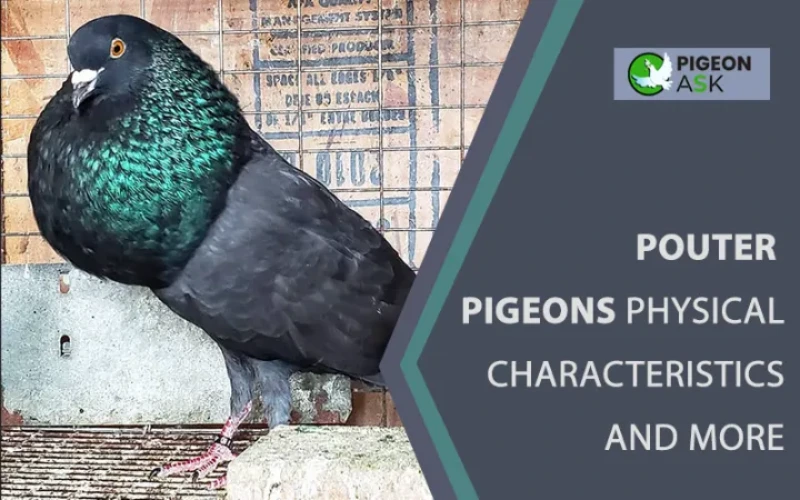
This article will discuss the history and origin, unique traits, distributions and habitats, feeding habits and nature of Pouter pigeons.
So, keep reading if this interests you and is right up your alley.
Pouter Pigeons’ Profile
| Name | Pouter Pigeon |
|---|---|
| Common Names | Pouters; Croppers |
| Origin | Europe |
| Size | 0.8 ft to 1.3 ft |
| Weight | 300-1000 grams |
| Lifespan | 01. Domestic: 5-15 years 02. Wild: 3-5 years |
| Physical Features | Slender body, big crops, small beak and head, long and feathered legs |
| Temperament | Calm, gentle and lively |
| Special Features | Possess an inflatable crop that can enlarge with air |
| Common or Popular Varieties | Pygmy pouter, English Pouter, Dutch Cropper, Norwich Cropper, Old German Cropper, Gaditano Pouters, Parisian, etc. |
Overview
Pouter pigeons, also known as Croppers – a category of fancy pigeons – are defined by their inflatable crops. They are among the earliest breeds and have quite a reputation in the pigeon world.
Pouter pigeons have always been admired for their ornamental crop and, therefore, are mostly kept as show birds by owners. It has been one of the oldest and most popular uses of pouter pigeons.
This pigeon breed is also used in sports. In some parts of the world, especially Spain, fanciers host a sport called the “thieving” that centers on pouters.
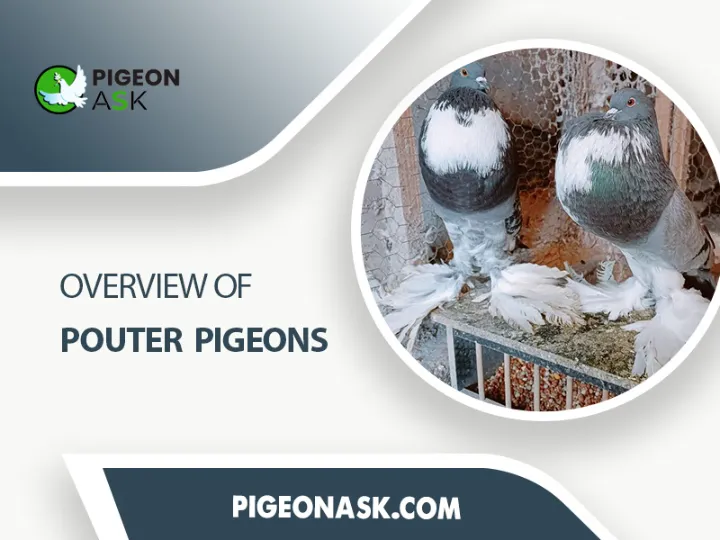
During the game, multiple participant pouters would try to woo each other and whichever takes the other one home wins.
They are aware of their beauty and are very proud, which is reflected in their walking and stance. While walking, pouters place their long legs with utter confidence – puffed up chest and straight back – as if it’s a fashion show.
Pouters, especially the English Pouters, are regarded as the supermodels of domestic pigeons. Their large breast inspired a female wardrobe that was very popular in the 20th century, aptly called the “pouter pigeon” dress.
History And Origins of Pouter Pigeons
It’s difficult to tell when the pouters were first bred. However, it is a popular belief that they were developed in Europe in the 17th century or before.
Europeans have been producing them for at least 400 years and have given birth to many fantastic pouter breeds, such as the English Pouters, Dutch Croppers, Parisian Croppers, Gaditano Pouters, Brunner Pouters, Norwich Croppers, etc.
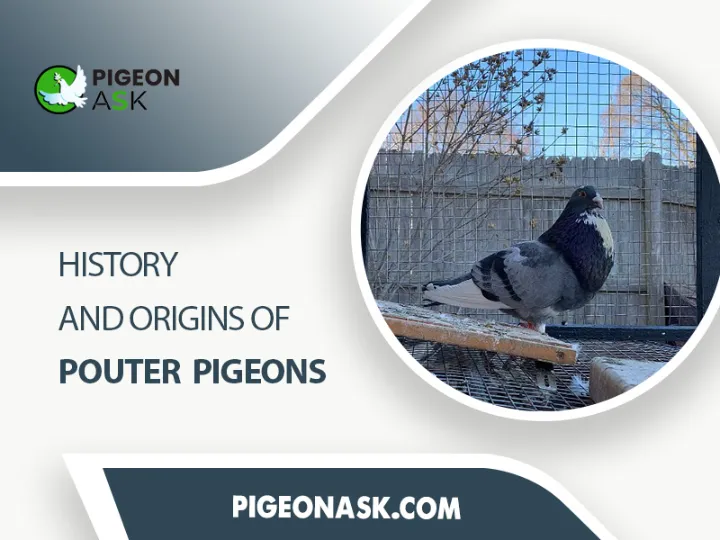
Dutch Croppers and Parisian Croppers are two of the oldest European breeds of pouter pigeons, existing since the 17th century. Many of the modern breeds came directly and indirectly from them.
The English Pouters were bred in the United Kingdom by crossing between Dutch and Parisian Cropper and Horseman Pouters.
This is why English pouters are also known as Pouting Horseman. Some pigeon experts say the Norwich Croppers originated from the English Pouters.
How They Were Bred and Developed?
Croppers came into existence like any other breed. Breeders noticed the tendency of some fancy pigeons to inflate their crops with air and they thought, why not make the crops even more extensive?
So, they started breeding. After carefully cross-breeding for some time, breeders were satisfied with the end result as they ended up with pigeons with exaggerated throats, long legs and slender bodies.
Charles Darwin was a big fan of pouter pigeons and called them “The Most Distinct Among All Domesticated Pigeons.”
While studying the variations of plants and animals under domestication, he experimented on the pouters and cross-bred them.
Different breeds of pouters were bred for various purposes. The Horseman Thief Pouters, for example, were bred to have the quality of seduction with a hint of homing instinct.
They are great at wooing pigeons and taking them home. This breed would instinctually start going at another pigeon, strutting their wings and wagging tails to seduce.
The whole of pouter pigeons, in general, indulge in the act of debauchery, with the Horsemans doing more so than others. Their seductive nature gave birth to the thieving sport that gives pleasure to many.
Physical Characteristics And Features
The Pouters are majestic and stand tall among their fellow fancy pigeons. Its expansive crop, a symbol of abundance, is a testament to its unique heritage.
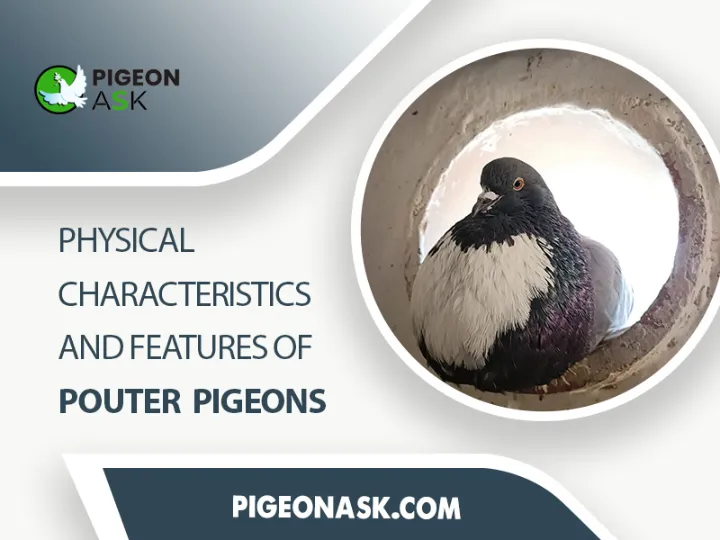
Long, smooth feathers cascade down its legs, adding to its elegant demeanor. The Brunner Pouter, a charming little fellow, boasts a round and prominent crop, a delightful contrast to its diminutive stature.
And then there’s the Pigmy Pouter, a wonder of miniature design, carrying a surprisingly large and round crop despite its petite size.
Each breed, with its own distinct characteristics and upright posture, holds a special place in the hearts of pigeon enthusiasts.
At a glance—
| Aspect | Description |
|---|---|
| Head | Dove-shaped |
| Crop | Enormous and inflated |
| Waist | V-shaped and long narrow |
| Wings | Slender |
| Legs | Long, strong, and covered with feathers |
| Height | The English Pouter is the tallest breed of fancy pigeons with some of the biggest ones being 16 inches in height |
| Body | Large and slim with a “V” shaped keel |
| Globe | Large and well-inflated round globe sharply sprung from the waist |
| Neck | Long |
| Color | Basic colors are black, blue, black check, blue check, dun, red, silver, and yellow |
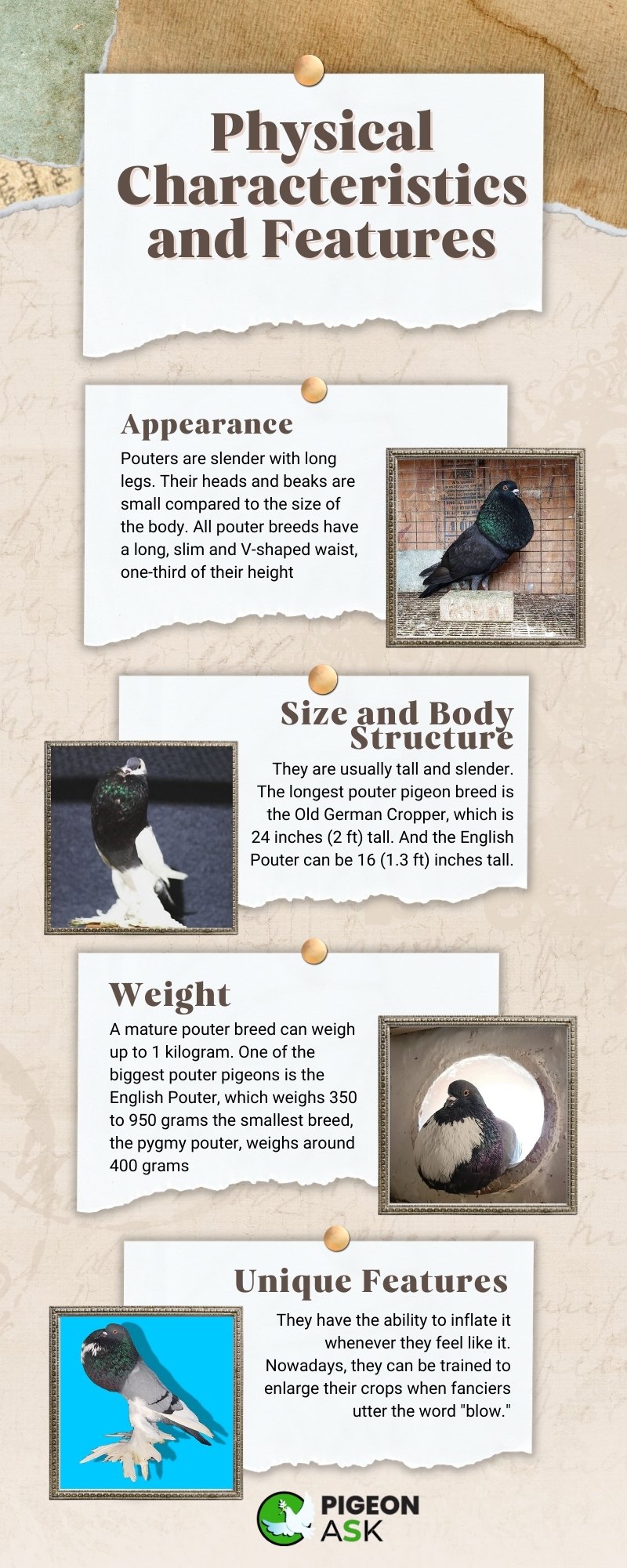
Appearance
Pouter pigeons can differ amongst breeds with various shapes, colors and feather patterns. They do share one thing – their infamous crop.
Pouters are slender with long legs. Their heads and beaks are small compared to the size of the body. All pouter breeds have a long, slim and V-shaped waist, one-third of their height.
They are proud birds and stand tall. And when walking, they look loyal. Additionally, pouter pigeons have long legs covered in smooth and fanned feathers.
Size and Body Structure
They are usually tall and slender. The longest pouter pigeon breed is the Old German Cropper, which is 24 inches (2 ft) tall. And the English Pouter can be 16 (1.3 ft) inches tall.
The Pygmy pouter is one of the smallest breeds of pouters. It can grow up to be 1 ft.
Weight
Their enlarged crops add weight and make them one of the heaviest fancy pigeons after Utility pigeons.
A mature pouter breed can weigh up to 1 kilogram. One of the biggest pouter pigeons is the English Pouter, which weighs 350 to 950 grams.
On the other hand, the smallest breed, the pygmy pouter, weighs around 400 grams. Another breed, the Gaditano pouters, weighs 300-850 grams.
Unique Features
All the fancy pigeon breeds have unique traits. The pouter pigeons are divided by shapes and variations but united by the enormity of their particular crop.
They have the ability to inflate it whenever they feel like it. Nowadays, they can be trained to enlarge their crops when fanciers utter the word “blow.”
Here are some different pouter pigeons and their distinctive features—
| Breed | Origin | Crop | Color |
|---|---|---|---|
| Birmingham Roller | England | Large, globular | Red, yellow, black, white, and various combinations |
| Ghent Pouter | Belgium | Large, rounded | Any solid color |
| Norwich Cropper | England | Large, oval | Black, red, yellow, dun, white, and various combinations |
| Pomeranian Pouter | Germany | Very large, elongated | Red, yellow, black, white, and various combinations |
| Swiss Pouter | Switzerland | Very large, globular | Black, red, yellow, white, and various combinations |
| Modena Pouter | Italy | Large, pear-shaped | Black, red, yellow, dun, white, and various combinations |
| German Pouter | Germany | Large, globular | Any color |
| Dutch Pouter | Netherlands | Very large, elongated | Black, red, yellow, white, and various combinations |
Some Common Variation in Colors and Markings Across Different Species
They come in various colors such as black, blue, white, etc. The Pygmy pouter usually has blue feathers, and English pouters have white or black feathers.
Pouter pigeons typically have outspread feathers on their feet. The English pouter’s leg feathers are white and the Saxon Pouters have brown feathers.
Distribution And Habitat
As pouter pigeons are domesticated, they can be found in human-built enclosures. However, you can also find many free and feral ones in the wild.
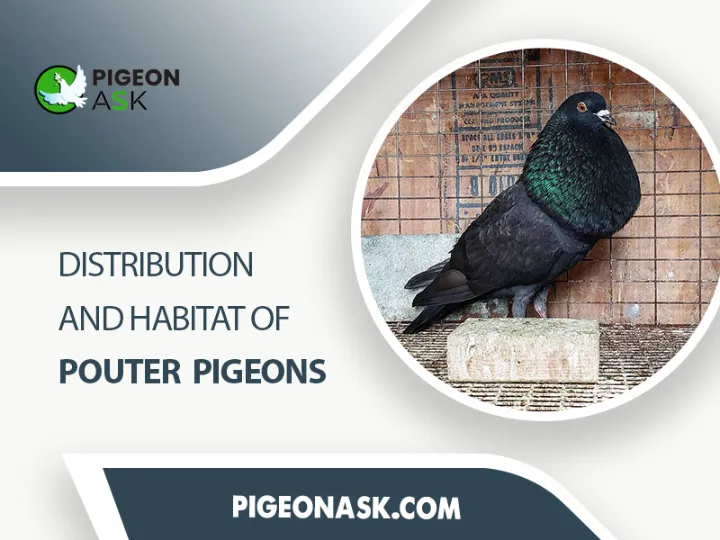
Regardless of being domesticated and wild, pigeons prefer living closer to human settlements for easy food and water and it can be seen in both urban and rural areas.
Geographic Distribution
Fancy pigeons are available on every continent and almost every country, although most pouter breeds originated in some European countries such as the UK, Germany, Netherlands, Spain, etc.
As their popularity grew, Pouters soon spread throughout the world. Even though pouter pigeons are not a product of the Indian subcontinent, they are an epidemic among fanciers around this part, like many other breeds.
Habitat Preferences
Pouter pigeons prefer places with abundant water and food. They like their loft and nests dry, clean and moderately high above the ground.
Moreover, pouter pigeons are territorial, making them choose spots that are secure from unwanted guests and predators and give them an advantage while fighting them off.
Urban and Rural Habitats
Pouter pigeons are usually bred by humans and kept in human-controlled habitats.
And it has been this way for hundreds of years. Therefore, pigeons have become highly dependent on humans as caregivers and most likely won’t survive on their own.
That said, you can find many in urban and rural areas.
In urban areas, feral ones choose window ledges, rooftops, ventilator spaces, flyovers, bridges, etc., to make their nests, any place that can keep them secure from predators, rain and the direct sun.
In rural areas, they choose abandoned homes, barns, farmhouses, trees, bushes, etc. The places they choose are typically around the locality.
Migration and Seasonal Movements
Pouter pigeons are not migratory. As a matter of fact, no pigeon breed does seasonal movement. The wild ones may go out looking for food and mate but do come back at the end of the day. And the caged ones, well, hardly leave their lofts.
Threats and Conservation Status
Pouter pigeons are abundant in nature and not under any threats. They, however, are prone to various health risks. For example, pouter pigeons’ crops require regular checkups as the object of their pride can deform their throat area and disrupt eating.
Behavior And Traits of Pouter Pigeons
Pouter pigeons are social and friendly and can learn to love their owners. They love seeking attention from humans. And they also love playing with the members of their flocks.
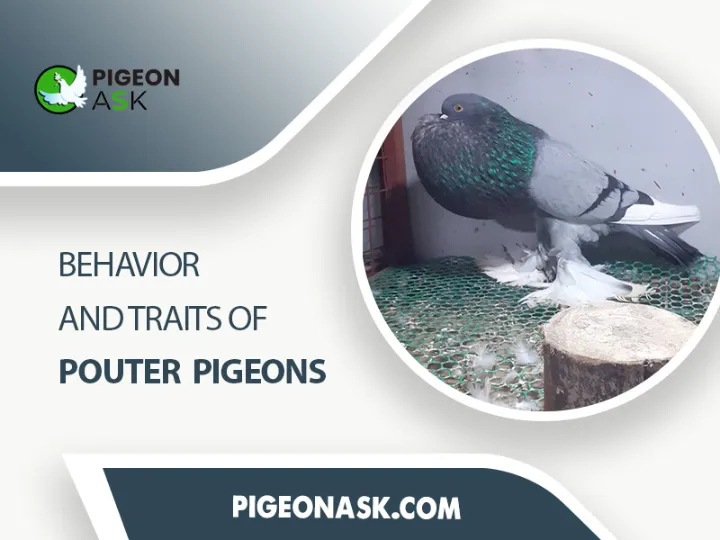
Moreover, they possess an inherent quality of wooing other pigeons, which they will do at the first chance they get. Fanciers utilize their wooing capability to steal or retrieve lost pigeons.
Differences Between Wild and Domesticated Pigeons
First off, wild pouters are not friendly toward humans. They live independently, manage their own food and fight off predators.
These pigeons live an eventful life before dying at the age of 3 to 5.
Domesticated Pouter pigeons are familiar with human interactions. They are inept at surviving on their own. As long as humans are taking care of them, pouters are going to thrive and live a long life.
Due to a good diet, domesticated pouters possess shiny and luscious feathers.
Diet
Pouter pigeons will eat whatever their owners provide, making them easy to maintain. They are granivorous. Therefore, you can give them grain and seed-based feed.
Additionally, it’s better to also provide these birds with insects, minerals, fruits and vegetables for the diet to be balanced.
Among fruits, Pouters prefer grapes, raisins, plums, cherries, blueberries, bananas and pears. Furthermore, you can give your pouters cruciferous and leafy vegetables such as cabbages, kale, radishes and spinach as part of a healthy diet.
Remember to serve them in edible shapes and sizes.
Nowadays, you can find pigeon feeds with balanced nutrition at pet stores or supershops. Experts suggest feeding those to get the most out of your pigeons.
Their diet must include grits for digestion, vitamins such as A, B complex, C, D, E and minerals (sodium, calcium, phosphorous, etc.)
Temperament
Pouter pigeons are docile and calm. They are very friendly with humans and interact like a dog would. It is said that Pouter pigeons are naturally tame and their gentle temperament makes them a suitable choice as pets.
Flight
Pouter pigeons are generally not good at flying due to their large crops. However, if trained at a young age before the crops develop, they can become great flyers.
They take flight like any other pigeon breed by spreading their wings and rapidly flapping them. Once mid-air, they habitually fly near another pigeon and show off their beautiful crops. They put on a show for them by performing acrobatic moves.
Nesting, Breeding and Courtship
Pouter pigeons make nests in secure places like roofs, attics, ledges, etc. They collect twigs, sticks, leaves, straws and pine needles to build the nest.
Pouter pigeons can breed up to 8 times throughout the year, depending on the weather conditions, their health and diets and the breeding cage. The female would lay 2 eggs. Both the parents take turns and incubate the eggs.
After hatching, the baby squabs are fed “pigeon milk” produced by glands in their crops.
Fanciers keep surrogate pigeons on standby as pouters due to their clumsy nature and heavy disposition may break eggs. Homing pigeons are a popular choice among fanciers as surrogates.
Sometimes, fanciers need to hand-feed the squabs, as pouters are often incompetent in doing so.
Pouter pigeons choose their mates for life. The bond both form is typically stable and long-lasting. Male would court the female by gently cooing, caressing and inflating their crops.
He would nod his head and spread tails and feathers to signal the female. The female, if interested, would reciprocate by coming close to the male and flaring her tail.
Lifespan
Domestic Pouter pigeons can live for 5-15 years. The Brunner Pouter has a lifespan of 7-10 years. Also, The English pouter can live a very long life. However, the domesticated Pouter pigeons, if left on their own, won’t survive for long.
The wild ones, compared to the domesticated ones, do not enjoy a long life. They can live for 3-5 years.
Homing Instinct
Pouter pigeons don’t have a homing instinct. The type of fancy pigeon that has the ability to return home flying hundreds of miles is aptly called the “Homing pigeon.”
Breeding And Maintenance
Pouter pigeons are not easy to raise and breed. They are sensitive regarding their homes and food. Moreover, they are very prone to many flu and avian diseases. As their caretaker, you have to be alert 24/7.
The first step to raising them is to build proper nests and lofts. They like dry and clean ground with a spacious loft that is vast enough to roam freely.
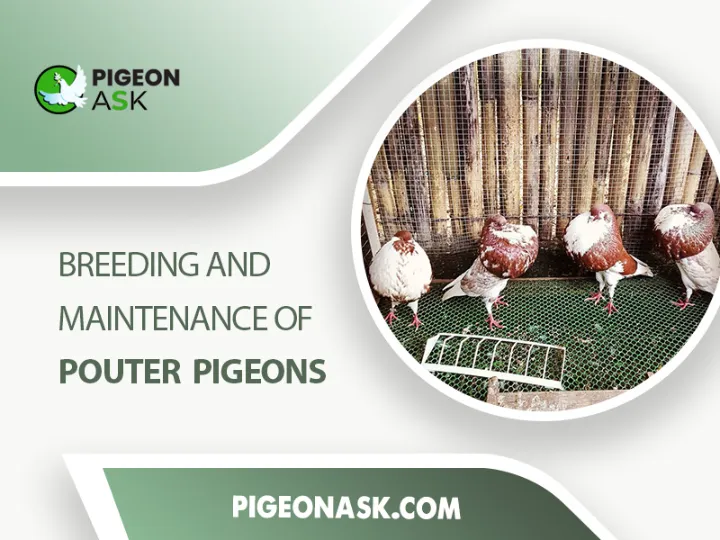
There should be a source of fresh water and grits around the loft. So, you should make sure they are getting all that.
During the breeding ground, they require the utmost care. You have to provide the female with extra minerals and nutrition for successful breeding.
A balanced diet and a suitable breeding ground are imperative for your pigeons to stay healthy and breed more often.
And as for diseases, you must do regular checkups and look for signs of sickness. It is necessary to take them to vets occasionally.
Some Tips and Considerations for Successful Breeding
Pouter pigeons require an optimal breeding environment, diet and temperature for successful breeding. A fun fact is that pigeons breed the healthiest squabs during winter.
The catch is they normally don’t give birth during this season and therefore, it takes great effort and preparation, which only a few fanciers end up achieving.
Below are some tips to accommodate your pigeons with the breeding process.
- 01. Make sure that your pigeon pair is healthy and free from parasites and pests. Take them to vets to give all the necessary vaccines (PMV and Salbac) and treatments for canker, coccid, etc.
- 02. You must clean the loft thoroughly and make sure the parasites and microorganisms are purged. You can clean with lime water to get a better result. Additionally, if you have a vacuum cleaner, use that to suck all the rubbish and burn them.
- 03. You have to give the female a combination of 85 percent oyster shell, 10 percent charcoal and 5 percent salt for successful breeding.
- 04. The floor must be dry and clean and have a heating option. And to provide adequate light and fresh air, you must set up artificial lights and ventilators to make sure of 16 hours of light and circulation of fresh air.
Finally, you can entertain the idea of keeping surrogate breeders ready, although it’s entirely optional and should not be a top priority.
Feeding and Housing Requirements
You can give your pigeons whatever you have around the house. They can eat about anything, mostly eating grains and seeds. But to achieve the best results, you should give them a balanced diet with adequate protein, vitamins and minerals.
You may buy pigeon feeds from stores that come in a perfect mixture, which should be adequate to fulfil your pigeons’ nutritional needs. Also, don’t forget to replace water and food every few hours.
The housing requirement of pouter pigeons is not absolute. So, the answer to the perfect size of the loft, aviary ground and resting nests differ from fanciers to fanciers. You are advised to create a budget and build a loft accordingly.
The general consensus is to build a 10-square-foot loft with a depth of 3 ft for your pigeons to be able to stretch their wings without any obstruction. And the loft ground should be made of wood and it should be shared among two pigeons only.
Additionally, you must build aviary grounds for your pigeon for sunlight and open space. It is suggested that the aviary ground be 8-10 square feet per pigeon and at least 6 feet tall.
Final Word
We are at the end of our article. Hopefully, you have learned a lot about pouter pigeons.
Pouter pigeons are used as show birds for their ornamental crops, which makes them quite a sight. These birds are a proud species and like showing off their globes before other birds and humans.
